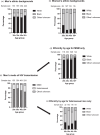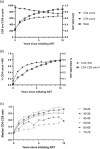Association of age at antiretroviral therapy initiation with CD4 + : CD8 + ratio recovery among virally suppressed people with HIV
- PMID: 38016172
- PMCID: PMC10942155
- DOI: 10.1097/QAD.0000000000003801
Association of age at antiretroviral therapy initiation with CD4 + : CD8 + ratio recovery among virally suppressed people with HIV
Abstract
Objective: To investigate the association of age at antiretroviral therapy (ART) initiation with CD4 + : CD8 + T-cell ratio in virally suppressed people with HIV on long-term ART, and to characterize potential CD4 + : CD8 + ratio recovery in this population by age.
Design: A longitudinal study of people attending an HIV clinic at the Royal Free Hospital NHS Trust, London, who initiated ART between 2001 and 2015, and achieved and maintained HIV-1 viral suppression (viral load <1,000 copies/ml). The association of age group at ART initiation with CD4 + : CD8 + ratio at 5 and 10 years was assessed.
Methods: Multivariable linear regression was used to investigate the relationship between age at ART initiation and log CD4 + : CD8 + ratio, adjusting for demographic factors (gender/HIV transmission route, ethnicity), baseline CD4 + count and calendar year.
Results: The sample included 1859 people aged 20-78 (75% men, 56% white ethnicity). Overall, median CD4 + : CD8 + T-cell ratio increased from 0.24 at baseline to 0.77 at year 5 and 0.88 at year 10. Ratios increased among all age groups in unadjusted and adjusted models but increased less among older ages (baseline ages 60-69 and 70-79). Median ratios at year 5 were 0.85, 0.80, 0.72, 0.76, 0.6, and 0.44, respectively, among people aged 20-29, 30-39, 40-49, 50-59, 60-69 and 70-79 years at baseline.
Conclusion: In a virally suppressed London population, age had a substantial impact on CD4 + : CD8 + ratio recovery, especially for those starting ART after age 60 years. Results may indicate the level of CD4 + : CD8 + ratio recovery possible in an HIV-positive, virally suppressed, aging population.
Copyright © 2024 The Author(s). Published by Wolters Kluwer Health, Inc.
Conflict of interest statement
There are no conflicts of interest.
Figures
Similar articles
-
Immune recovery in HIV-1 infected patients with sustained viral suppression under long-term antiretroviral therapy in Ethiopia.PLoS One. 2020 Oct 22;15(10):e0240880. doi: 10.1371/journal.pone.0240880. eCollection 2020. PLoS One. 2020. PMID: 33091053 Free PMC article.
-
Incomplete Antiretroviral Therapy Adherence Is Associated with Lower CD4-CD8 Ratio in Virally Suppressed Patients with HIV Infection in Mexico.AIDS Res Hum Retroviruses. 2023 Mar;39(3):136-144. doi: 10.1089/AID.2021.0179. Epub 2023 Feb 15. AIDS Res Hum Retroviruses. 2023. PMID: 36597354 Free PMC article.
-
Aging, trends in CD4+/CD8+ cell ratio, and clinical outcomes with persistent HIV suppression in a dynamic cohort of ambulatory HIV patients.AIDS. 2022 May 1;36(6):815-827. doi: 10.1097/QAD.0000000000003171. Epub 2022 Jan 10. AIDS. 2022. PMID: 35013081 Free PMC article.
-
CD4+:CD8+ T-cell ratio changes in people with HIV receiving antiretroviral treatment.Antivir Ther. 2020;25(2):91-100. doi: 10.3851/IMP3354. Antivir Ther. 2020. PMID: 32338638
-
Interferon lambda rs368234815 ΔG/ΔG is associated with higher CD4+:CD8+ T-cell ratio in treated HIV-1 infection.AIDS Res Ther. 2020 Apr 15;17(1):13. doi: 10.1186/s12981-020-00269-0. AIDS Res Ther. 2020. PMID: 32295609 Free PMC article.
Cited by
-
Multi-omics dissection of metabolic dysregulation associated with immune recovery in people living with HIV-1.J Transl Med. 2025 Jan 31;23(1):143. doi: 10.1186/s12967-025-06168-0. J Transl Med. 2025. PMID: 39891216 Free PMC article.
-
Decoupled dynamics of absolute and relative lymphocyte counts and age-polarized CD4+/CD8+ ratio in infants versus older adults.Front Immunol. 2025 Jul 24;16:1599515. doi: 10.3389/fimmu.2025.1599515. eCollection 2025. Front Immunol. 2025. PMID: 40777005 Free PMC article.
References
-
- Nakagawa F, May M, Phillips A. Life expectancy living with HIV: recent estimates and future implications. Curr Opin Infect Dis 2013; 26:17–25. - PubMed
-
- Kirby T. Three in five over 50 s receiving late HIV diagnoses in the UK. Lancet HIV 2020; 7:e226. - PubMed
-
- Elford J, Ibrahim F, Bukutu C, Anderson J. Over fifty and living with HIV in London. Sex Transm Infect 2008; 84:468–472. - PubMed
-
- Sabin CA, Reiss P. Epidemiology of ageing with HIV: what can we learn from cohorts?. AIDS 2017; 31: (Suppl 2): S121–S128. - PubMed
MeSH terms
Substances
LinkOut - more resources
Full Text Sources
Medical
Research Materials



